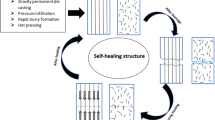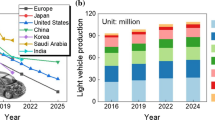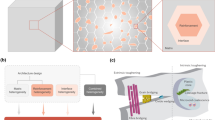Abstract
The structure and interfacial interaction are studied in the hybrid aluminum-matrix composite materials fabricated by reactive casting combined with mechanical mixing of fillers with a metallic melt. The following types of hardening are considered: hardening by ceramic particles and by the phases formed as isolated inclusions or coatings on ceramic particles during in situ reactions. The hardness and tribological properties of the composite materials as functions of their compositions are discussed.
Similar content being viewed by others
References
T. A. Chernyshova, L. I. Kobeleva, and L. K. Bolotova, “Discontinuously reinforced composite materials with aluminum alloy matrices and their tribological properties,” Russian Metallurgy (Metally), No. 6, 85–98 (2001).
T. A. Chernyshova, L. I. Kobeleva, and T. V. Lemesheva, “Precipitate-filled composite materials based on antifriction silumine for sliding friction units,” Perspektivnye Materialy, No. 3, 69–75 (2004).
H. Fukunaga, G. Sasaki, I. Tsuchitori, T. Fujii, and N. Fuyama, “Reaction squeeze cast processing and intermetallics dispersed aluminum matrix composites,” in Proceedings of 11th International Conference on Composite Materials (ICCM-11), Australia (1997), Vol. III, pp. 182–191.
A. A. Panfilov, A. V. Panfilov, T. A. Chernyshova, L. I. Kobeleva, and L. K. Bolotova, “New aluminummatrix composite materials fabricated in situ,” in Proceedings of the International Conference on the Theory and Practice of the Production of Articles Made of Composite Materials and New Metallic Alloys (TPKMM), Moscow, Russia (Znanie, Moscow, 2004), pp. 136–140.
T. V. Christy, N. Murugan, and S. Kumar, “A comparative study on the microstructures and mechanical properties of Al6061 alloy and the MMC A16061/TiB2,” J. Miner. Mater. Character. Eng. 9(1), 57–65 (2010).
S. Kumar, M. Chakraborty, V. Sarma Subramanya, and B. S. Murty, “Tensile and wear behaviour of in situ Al-7Si/TiBPin2 particulate composites,” Wear 265(1–2), 134–142 (2008).
R. S. Mikheev, I. E. Kalashnikov, L. I. Kobeleva, and T. A. Chernyshova, “Development of Al-Ti-TiC composite materials,” Fiz. Khim. Obrab. Mater., No. 3, 18–25 (2009).
A. R. Kennedy and B. Brampton, “The reactive wetting and incorporation of B4C particles into molten aluminium,” Scripta Materialia 44, 1077–1082 (2001).
A. R. Kennedy, “The microstructure and mechanical properties of Al-Si-B4C metal matrix composites,” J. Mater. Sci. 37, 317–323 (2002).
A. V. Chichinadze, E. M. Berliner, E. D. Brakn, et al., Friction, Wear, and Lubrication (Tribology and Tribological Engineering) (Mashinostroenie, Moscow, 2003).
V. I. Nikitin and K. V. Nikitin, “Scientific principles of designing a new class of fine-grained modifiers for metallic melts,” in Proceedings of the IV International Conference on Theory and Practice of Producing Articles of Composite Materials and New Metallic Alloys (TPKMM), Moscow (Znanie, Moscow, 2006), pp. 297–307.
T. A. Chernyshova, L. I. Kobeleva, P. Shebo, and A. V. Panfilov, Interaction of Metallic Melts with Reinforcing Fillers (Nauka, Moscow, 1993).
T. A. Chernyshova and A. V. Rebrov, “Interaction kinetics of boron carbide and silicon carbide with liquid alumimium,” J. Less-Common Metals 117, 203–207 (1986).
H. Zhu, H. Wang, and L. Ge, “Wear properties of the composites fabricated by exothermic dispersion reaction synthesis in an Al-TiO2-B2O3 system,” Wear 264(11–12), 967–972 (2008).
Min Zhao, Longtao Jiang, and Zuoyong Don, “Friction and wear properties of TiB2/Al composite,” Composites A 37, 1916–1921 (2006).
Tang Feng, Wu Xiaoling, Ge Shirong, Ye Jichun, Zhu Yua, Hagiwara Masuo, and M. Schoenung Julie, “Dry sliding friction and wear properties of B4C particulate-reinforced Al-5083 matrix composites,” Wear 264, 555–561 (2008).
Author information
Authors and Affiliations
Corresponding author
Additional information
Original Russian Text © T.A. Chernyshova, L.I. Kobeleva, L.K. Bolotova, I.V. Katin, 2013, published in Metally, 2013, No. 2, pp. 73–82.
Rights and permissions
About this article
Cite this article
Chernyshova, T.A., Kobeleva, L.I., Bolotova, L.K. et al. Structure and properties of hybrid composite materials. Russ. Metall. 2013, 220–228 (2013). https://doi.org/10.1134/S003602951303004X
Received:
Published:
Issue Date:
DOI: https://doi.org/10.1134/S003602951303004X




